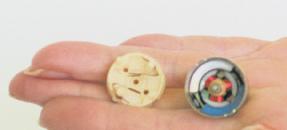
In these activities we discovered two ways that electricity and magnetism are related: an electrical current causes a magnetic field, and a changing magnetic field causes a voltage.
A current causes a magnetic field
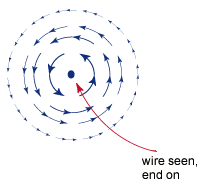
The magnetic field of a current-carrying wire will push on a compass needle (a magnet), making it deflect, and a magnet will push on a current-carrying wire, making the wire itself move. The direction of the magnetic field is different than the direction of the current -- in fact, it tends to run around the wire in circles (the earth's magnetic field distorts this and makes it harder to observe).
The magnetic field of one wire is not very big, but we can make it bigger by making a coil -- this way, each wire gives rise to a magnetic field, which then add together. An iron core for the magnet (like the nail that we used) will gather together the magnetic field and make it stronger in some places. Since we can turn a current on and off, this effect allows us to turn on and off the magnetic force on a magnet, making possible motors, buzzers, doorbells, and electrically operated switches, valves, and locks; electromagnets are also used to turn electrical signals into sound in stereo speakers, to steer the electron beam that draws the picture on a TV tube, and to write information on your computer's hard drive and floppy disks. The electromagnet plays an important role in the technology of our world!
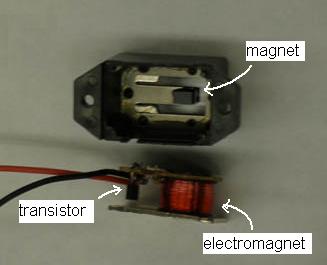
If you pry the bottom off of a buzzer, here is what you will
find inside: clearly visible is the electromagnet coil, and there
is a small magnet glued to a thin metal strip at the top of the
plastic case. The other electrical components are a few resistors,
a capacitor, and a transistor -- these turn the current on and off,
which gives rise to a field that also turns on and off; this pulls
on the magnet, keeping the metal strip vibrating.

Here is what is inside the motor in your kit. Instead of a single coil, there are three coils, wrapped on an iron form. These are connected to metal plates on the motor shaft, and electrical contact is made to the plates by parts called "brushes" that rub against the turning shaft (these are little brass parts that are still attached to the beige end piece of the motor). As the motor turns, different coils are turned on; they are attracted and repelled by permanent magnets (colored blue and white in the picture).
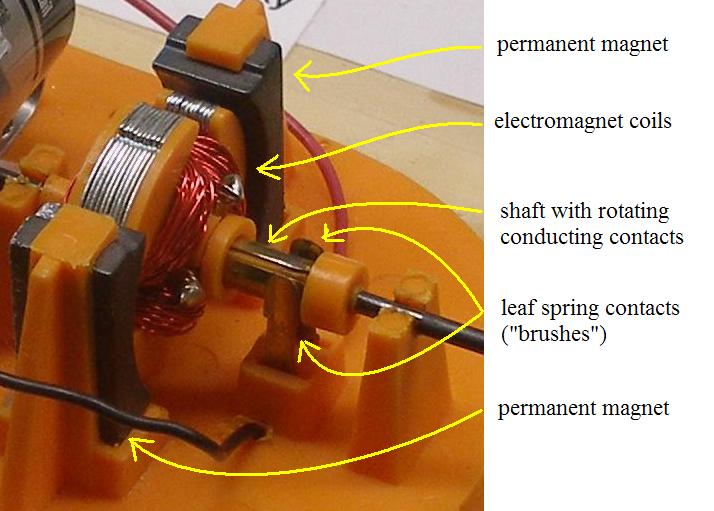
We found that we could make a light-emitting diode blink by suddenly disconnecting the battery from an electromagnet. There is energy stored in the magnetic field of an electromagnet, so the field cannot just instantly cease to exist. Yet, for the field to persist, a current has to flow. The result is a sort of electrical inertia in which the current cannot instantly stop, and will take any path that is available to it -- in our case, through the L. E. D. The energy that was in the magnetic field is released in the form of visible light. We say "A changing magnetic field induces a voltage," and the "electrical inertia" is called This effect is what allows us to turn mechanical energy ( turning wheels) into electrical energy. Large coils are moved past large magnets; this causes energy to be converted from the magnetic field into electrical form.
The induction effect can be a nuisance sometimes. When the brushes of an electrical movor move from one contact to another, it is switching off one electromagnet and turning on another. This creates large voltages which will make sparks jump at the electrical contacts. The sparks sometimes make ozone (the "electrical" smell) and erode away the brushes and the contacts. induction.
Comparing electricity to a flowing fluid
It was useful to compare an electrical current to the flow of
water in a pipe while we were talking about conductors and
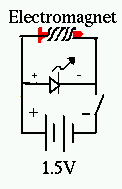 nonconductors and even
capacitors; however, the fluid system does not have any analog to
the magnetic effect. However, there is a fluid analogy to the
induction effect we discovered when we studied the circuit shown at
right: if you suddenly stop the flow of a fluid, you will get a
high pressure surge in the pipeline.
nonconductors and even
capacitors; however, the fluid system does not have any analog to
the magnetic effect. However, there is a fluid analogy to the
induction effect we discovered when we studied the circuit shown at
right: if you suddenly stop the flow of a fluid, you will get a
high pressure surge in the pipeline. 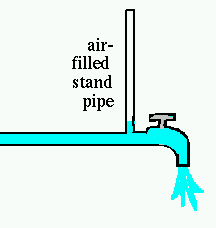 You may notice this as a "bump" occurring when your
washing machine or dishwasher ends a rinse or fill cycle, or even
when you turn off a faucet. In this context the effect is called
"water hammer" and it is quite undesirable -- it is exactly the
equivalent of hitting your pipes with a hammer! In household piping
it is common to include an air-filled standpipe to soften the blow
. Now the energy of the flowing water is used to compress the air
in the pipe, which makes the pressure surge much smaller. If you
are hearing water hammer in your pipes, it may mean that the air
has leaked out of the standpipe -- you can cure this by turning off
the water supply to the house and opening the highest and lowest
faucet in the house -- this will drain all the pipes and refill
them with air. Then turn off the faucets and turn the water back
on, and things should work better.
You may notice this as a "bump" occurring when your
washing machine or dishwasher ends a rinse or fill cycle, or even
when you turn off a faucet. In this context the effect is called
"water hammer" and it is quite undesirable -- it is exactly the
equivalent of hitting your pipes with a hammer! In household piping
it is common to include an air-filled standpipe to soften the blow
. Now the energy of the flowing water is used to compress the air
in the pipe, which makes the pressure surge much smaller. If you
are hearing water hammer in your pipes, it may mean that the air
has leaked out of the standpipe -- you can cure this by turning off
the water supply to the house and opening the highest and lowest
faucet in the house -- this will drain all the pipes and refill
them with air. Then turn off the faucets and turn the water back
on, and things should work better.
Applications of the induction effect
Making the shaft of a motor spin causes the wire coils in it to move past magnets. The changing magnetic field seen by the coils causes voltages can make currents move. An electrical generator is an electrical motor run backwards, turning mechanical energy into electrical energy.
Another way to observe the ability of changing magnetic fields
to give rise to electrical effects is to wrap two coils around an
iron core
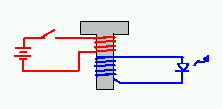
One coil is a circuit containing a switch, while the other contains
a current detector, such as a light-emitting diode. When you turn
the current on and off, the LED will blink, even though no current
can pass from the circuit with the battery into the circuit with
the LED. The changing magnetic field that is caused by the first
coil makes currents move in the second coil, and transfers energy
from one circuit to the other.
If the number of turns in the two coils of this device are different, the voltage levels in the two sides are also different. Used this way this is a transformer.
Electrical energy is distributed over power lines using alternating current. The current is reversing direction 120 times per second. The energy is moved from power plant to the city at high voltage, because this is an efficient way to move energy; transformers can then convert this into lower voltages that are safer around the house. Our electrical distribution system would not be possible without the electromagnetic effect that makes transformers work.
Check the box when you are
done:
Next:Discussion of electromagnetism